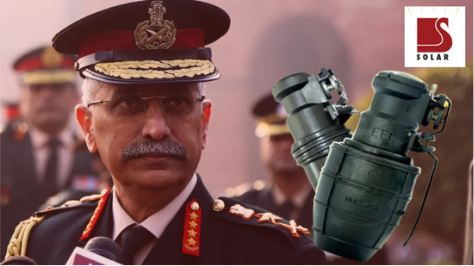On Tuesday, August 24, the first batch of India-made multi-mode hand grenades (MMHG), manufactured by a private firm named Economic Explosives Limited (EEL) was delivered to the Indian Army in the presence of Defence Minister Rajnath Singh at a ceremony in Nagpur. The development of the grenade was made possible following the transfer of technology from the Terminal Ballistics Research Laboratory of Defence Research & Development Organisation (DRDO).
Speaking at the handing over ceremony, Union Defence Minister Rajnath Singh heaped praise on the organisation. He said, “I am delighted that the production was approved in March 2021 and within five months more than one lakh grenades have been manufactured even when the second wave of Covid-19 was going on and the entire system had come to a standstill. These grenades have been manufactured by the private sector. I think this is a great example of a public-private partnership in defence sector.”
EELs success in manufacturing and delivering the hand grenades has made the subject experts take notes and suggest that it could follow the trajectory of similar private foreign firms who cater to developing military equipment. France based Dassault and US based Raytheon to name a few.
Soon after Narendra Modi became the Prime Minister of India, the Make in India initiative was launched in September 2014 with a wider objective of nation-building by making India a global design and manufacturing hub.
Changes were made to the obsolete rules and regulations to encourage manufacturers to set up their units in India. Different sectors from Defence to Railways were streamlined for investment and rudimentary regulations in these sectors were scrapped to improve ease of doing business.
The Aatmanirbhar Bharat campaign has also recognised Defence as the major sector where India needs to pull up its socks and become, if not entirely but somewhat self-sufficient. Currently, India, the third-biggest military spender in the world, is also the second-largest importer of arms transferred between 2016-20, with a share of 9.5% of global arms imports.
Self-sufficiency in Defence manufacturing for India is critical as India strides ahead in the 21st century in an increasingly hostile neighbourhood. Moreover, developing defence equipment on its own can help modernise the forces as well.
It is usually seen that the foreign countries exporting/selling the military equipment are giving us outdated technology. Even then, the said equipment comes with several caveats that it can only be repaired in the host country and that the transfer of technology will be limited.
Taking the Make In India and its motto to the core, Rajnath Singh had earlier this year earmarked around 64 per cent of the Defence Ministry’s modernisation funds under the capital acquisition budget for 2021-22 — a sum of over Rs 70,000 crore — for purchases from the domestic sector.
The Light Combat Aircraft Tejas (83 of which have been ordered), transport aircraft C-295 (to be manufactured by Tata-Airbus, deal with the government in final stages), and the AK-203 rifles (to be made in India as part of a joint venture between the Ordnance Factory Board, Kalashnikov Concern, and Rosoboronexport, the Russian state agency for military expo) are few of the many domestic projects in the pipeline.
And while the domestic market booms, India has also started focusing on exporting arms and ammunition to other nations. A possibility that was relatively unexplored by the previous government regimes.
As per the data published by the Stockholm International Peace Research Institute, or SIPRI, in March 2020, India is ranked 23rd in the list of major arms exporters for 2015-2019 and 19th for 2019. The Ministry of Defence’s annual report 2018-19 records that the defence exports were worth Rs 10,745 crore, a growth of more than 100 per cent from 2017-18 (Rs 4,682 crore) and over 700 per cent since 2016-17 (Rs 1,521 crore).
PM Modi at the DefExpo last year had stated, “In 2014, the export of defence equipment from India was about Rs 2,000 crore. In the last two years, it has gone up to Rs 17,000 crore. In the next five years, our target is to increase exports to $5 billion, which is about Rs 35,000 crore.”
The government has done away with a lot of red-tapism in the sector and hence firms like EEL, in such a short period have been able to deliver the results. This might just be the starting of something special and if the Modi administration continues its focus on revitalizing the domestic market, several more companies on the line of EELs success can crop up.
